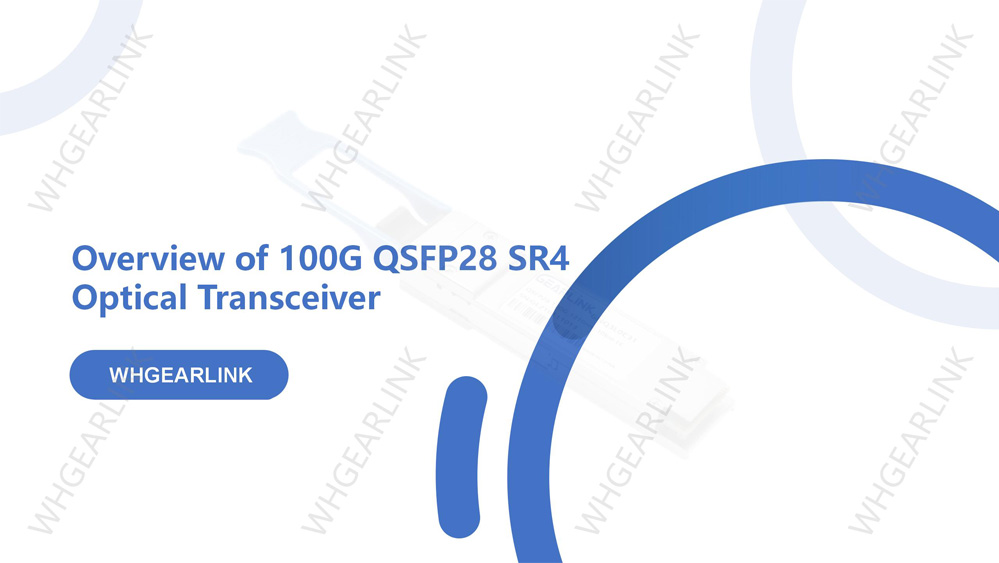
Abstract: The 100G QSFP28 SR4 optical module has a rate of 100Gbps, uses QSFP28 packaging, and uses multi-mode optical fiber. The full-duplex module provides 4 independent channels with addressable and closed channels. The modules are accessed via a two-wire serial interface and offer high functionality and integration. With the advantages of high bandwidth, high density, and pluggability, it provides high-performance solutions for high-performance computing and data centers.
The 100G SR4 optical module is a high-performance data center solution that uses multi-mode optical fiber technology to support data transmission rates up to 100Gbps. It provides the advantages of high density and high bandwidth in a compact QSFP28 package, and is suitable for short-distance data transmission needs. The reliability and flexibility of 100G SR4 make it an important part of modern network architecture.
SR stands for Short Range Multimode Fiber, and 4 means there are four fiber channels.
100G SR4 optical module is a parallel 100Gb/s Quad Small Form-factor Plug-gable (QSFP28) optical module. It provides increased port density and total system cost savings. The QSFP28 full-duplex optical module offers 4 independent transmit and receive channels, each capable of 25Gb/s operation for an aggregate data rate of 100Gb/s on 100 meters of OM4 muti-mode fiber.
An optical fiber ribbon cable with an MTP/MPO connector can be plugged into the QSFP28 module receptacle. Proper alignment is ensured by the guide pins inside the receptacle. The cable usually cannot be twisted for proper channel to channel alignment. Electrical connection is achieved through an MSA-compliant 38-pin edge type connector.
100G SR4 optical module operates by a single +3.3V power supply. LVCMOS/LVTTL global control signals, such as Module Present, Reset, Interrupt and Low Power Mode, are available with the modules. A 2-wire serial interface is available to send and receive more complex control signals, and to receive digital diagnostic information. Individual channels can be addressed and unused channels can be shut down for maximum design flexibility.
100G SR4 optical module is designed with form factor, optical/electrical connection and digital diagnostic interface according to the QSFP28 Multi-Source Agreement (MSA). It has been designed to meet the harshest external operating conditions including temperature, humidity and EMI interference. The module offers very high functionality and feature integration, accessible via a two-wire serial interface.
The 100G QSFP28 SR4 optical module uses four parallel multi-mode fiber channels for data transmission. Each channel has a rate of 25Gbps, providing a total of 100Gbps data transmission capability. The four optical fiber channels on the module transmit the signals at the transmitter end respectively, and then recombine them into an overall signal at the receiver end.
100Gbase-SR4 specifications

100Gbase-SR4 Features
nlComplies with QSFP28 MSA
nlConforms to IEEE802.3bm 100GBASE-SR4
nlFour independent full-duplex channels
nlSupports 103.1Gb/s aggregate bit rate
nlOM4 MMF transmission up to 100 meters
nlOperating temperature: 0 to 70 degrees Celsius
nlSingle 3.3V power supply
nl4x25G electrical interface (OIF CEI-28G-VSR)
nlMaximum power consumption 2.5W
nlMTP/MPO fiber optic connector
nlRoHS-6 compliant
The main advantages of 100G QSFP28 SR4 optical module:
1. High bandwidth: Supports 100Gbps data transmission rate to meet the needs of high-performance computing and data centers.
2. High density: Due to the use of QSFP28 interface, higher port density can be achieved and cabinet space can be saved.
3. Plugability: The module has a hot-swappable function and can be easily installed and replaced.
1. What is the distance of 100G SR4?
100G SR4 is generally suitable for short-distance transmission, with transmission distances generally between 70 and 100 meters, depending on the type and quality of fiber used.
2. What is the difference between 100G SR10 and SR4?
100G SR10 and SR4 are two different optical module types. The 100G SR10 optical module is packaged in CFP. SR10 uses 10 channels for transmission. Each channel has a rate of 10Gbps, providing a total of 100Gbps data transmission capability. The 100G SR4 optical module is packaged in QSFP28 and uses 4 channels for transmission. Each channel has a rate of 25Gbps and also provides 100Gbps data transmission capability. In addition, SR10 is usually used for long-distance transmission, while SR4 is used for short-distance transmission. 100GBASE-SR4 uses a 12-core MPO/MTP jumper, while 100GBASE-SR10 uses two 12-core or one 24-core MPO/MTP jumper.
The size of CFP is much larger than that of QSFP28. The use of QSFP28 greatly reduces the number of wiring. All in all, QSFP28 increases the density of the front panel, reduces power consumption, is relatively cheap, and can also save wiring costs. Therefore, CFP has been replaced by QSFP28.
3. QSFP28-100G-SR4 price
The price of QSFP28-100G-SR4 depends on the supplier and market conditions. Prices will vary due to market competition and other factors. It is recommended that you consult the supplier or conduct research in the market to obtain the most accurate price information.
4. QSFP28-100G-SR4 disconnected
If your QSFP28-100G-SR4 optical module has a disconnection problem, there may be several reasons why this happens:
a. Optical fiber connection problem: Please ensure that the optical fiber connection is firm and not loose or broken. Check whether the fiber optic connector is correctly inserted into the module and the corresponding interface.
b. Fiber quality issues: Low-quality optical fiber may cause signal weakening or loss. Try changing the fiber to a high quality multi-mode fiber.
c. Optical module failure: There may be a failure in the optical module itself. Try to replace the optical module with another working optical module to determine whether the module is the problem.
d. Compatibility issues: In some cases, there may be compatibility issues between optical modules and other devices. Make sure the optical module is compatible with your device and see if a software or firmware update is required.
If the problem persists, it is recommended that you contact the relevant vendor or technical support team for further assistance and solutions.

